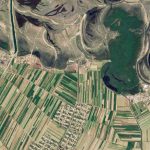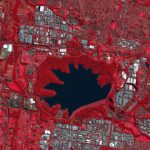Planet, Microsoft, and Researchers Build New AI-focused Resource for Environmental Reporting
Authors: Seamus Lombardo and Amy Rosenthal
As a Public Benefit Corporation, we think a lot about sustainability and the solutions our customers, partners, and the world need. These solutions require an up-to-date, close-up view of the Earth, as well as the deep analytics that provide reliable, quantitative insights about how Earth’s surface is changing. From climate-disrupting emissions to tropical deforestation, Planet is developing the tools to help organizations track impacts and opportunities across the value chain, and to translate this intelligence into robust strategies and practical platforms. We are expanding this portfolio with a white paper guide to help navigate new sustainability reporting demands around nature-related impacts and dependencies – Accelerating Biodiversity and Ecosystem Reporting, written in collaboration with Microsoft, the Natural Capital Project, and the Gund Institute at the University of Vermont.
Sustainability is about understanding the state and implications of business activities, taking action to improve outcomes, and tracking the results as impacts shrink and nature-aligned opportunities grow (Figure 1). Planet data and imagery can aid in all stages of sustainability reporting.
- Planet products can help you locate where your assets interface with the environment. For example, Planet, Ordnance Survey, Esri UK, Deloitte, and Trase have established the Supply Chain Data Partnership (SCDP) to provide a location dataset for global supply chains such as palm oil, soy, and wood-based packaging applications.
- Planet imagery and data can help evaluate your environmental risks and impacts. Using Planet imagery and the global Ecosystem Services Footprinting Tool, the Natural Capital Project and Morgan Stanley’s Institute for Sustainable Investing assessed impacts of lithium mining in the supply chain.
- Planet products can inform plans and strategies to reduce impacts and improve outcomes. Bayer Environmental Science has used Planet data to assess invasive species of vegetation and establish management regimes.
- Planet analytics can help you track the benefits of nature-positive actions over time. Justdiggit used our Planetary Variables products to evaluate the success of efforts to restore life in drought-laden deserts with locally dug bunds.
An emerging area of sustainability is biodiversity and ecosystem reporting. As scientists document the rapid decline of nature globally, frameworks have arisen to illuminate the materiality of environmental changes for business investors and consumers – including both compliance-based regulations such as the EU Corporate Sustainability Reporting Directive (CSRD) and voluntary frameworks like the Taskforce on Nature-Related Financial Disclosures (TNFD). In contrast to climate reporting on a few global metrics, biodiversity and ecosystem reporting involves tracking a daunting variety of indicators whose metrics are dependent on localized data and conditions. Fortunately, recent advances in ecosystem science, Earth observation (EO), and artificial intelligence (AI) make scientifically robust reporting more achievable and cost-effective.

In Accelerating Biodiversity and Ecosystem Reporting, we take readers step-by-step through biodiversity and ecosystem reporting, from scoping to assessing and reporting, as illustrated in the figure above. We review concrete examples from industry and the scientific literature demonstrating how recent advances in EO, AI, and ecosystem science can help deliver up-to-date and actionable insights for biodiversity and ecosystem metrics, from ecosystem conversion to the state of species. We indicate how EO and AI-enabled measurement techniques and data sources are scalable, interoperable, and easily integrated into company workflows. These tools enable companies to report material dependencies and impacts and set meaningful, attainable targets and policies for nature-positive actions.
To help users get started with reporting immediately, we survey dozens of data sources and tools and review many of the options currently available. We provide thought leadership on the current challenges and provide recommendations on how corporate, regulatory, and scientific actors can collaborate to address them quickly and effectively. We note that companies that adopt biodiversity and ecosystem reporting early, starting with what’s currently operational and incorporating additional measures as new data and tools become more readily available, will help shape the future trajectory of nature-related reporting.
In this decisive decade for climate change and biodiversity, Planet is committed to helping our users realize their sustainability ambitions and accelerate their trajectory towards a carbon-neutral, nature-positive future. Planet imagery and insights can help companies measure their environmental impacts, dependencies, and opportunities across a range of sustainability topics and reporting frameworks. We look forward to working with you to weave a future that protects the planet and sustains the web of life on which we all depend. The time to get started is now.




